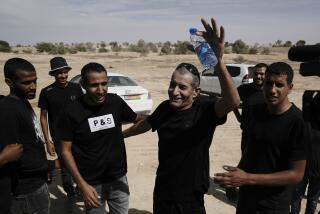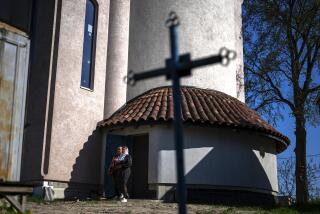Catholic Village Is No Stranger to War
HARMOTA, Iraq — Not far from battlefields where Islamic armies once laid siege to Christian villages, wind seeps through the Church of the Virgin as Yusif Toma Yusif dips a finger in holy water and heads over a stony path toward home to bake communion hosts for a dwindling congregation.
“This is from the Vatican,” he says, holding an iron press etched with intricate Latin letters in the design of a wafer. “I can make one in two minutes. It is only wheat flour. Altar wine takes longer, about 40 days.”
Catholic rituals have been practiced in this northern Iraqi village for centuries. They survived the conquests of Islamic armies in AD 638. They echoed through the Ottoman empire, world wars, civil wars, uprisings, “ethnic cleansing” and bloodletting by Iraqi President Saddam Hussein’s forces. Another battle is coming, villagers say, one with weapons and technology few of the olive growers and mountain shepherds can comprehend.
“Fighting and torment have spoiled this land for so long,” said Slewa Issa Kareem, a village elder who is hoping for a U.S.-led military campaign against Iraq. “It’s so bad under Saddam that we even prefer an outside invader to save us from him.”
With its band of Chaldean Catholic families, Harmota is a swath in the larger, often mesmerizing pattern of minority cultures and religions in this predominantly Muslim enclave of northern Iraq known as Kurdistan. There are Assyrians, Arabs, Armenians and Turkomans. There are tribes such as the Hamawand and clans such as the Surchi. Over the centuries, each has counted victories and defeats as power changed hands against the brutal rhythms of land and politics.
They are suspicious of one another and of the area’s two ruling Kurdish parties -- the Patriotic Union of Kurdistan and the Kurdistan Democratic Party. But their hatred of Hussein has for a time muffled their regional grievances and unified them against a ruler who has unleashed chemical weapons on them, destroyed more than 1,200 villages, killed at least 180,000 people and vowed to turn Iraq into an inferno if attacked by U.S. troops.
“Hussein didn’t differentiate between our cultures or religions,” said Kareem, a tall man with thick glasses, called from his afternoon tea when a visitor entered the village. “Saddam burned the wet and the dry together. To him, there is no difference. He wants to destroy everyone.”
“This is true,” said his friend, Issa Kareem Ishaq, whose hands are coarse and whose face is as wrinkled as a fishing net.
Sitting in the flatlands, not far from the Muslim city of Koysinjaq, the village of Harmota straddles a narrow road crisscrossed by cows and children. The population has fallen from 105 families in the 1960s to 70 today. The wheat and bean fields are fertile and newly plowed. Sparrows and doves flit through orange trees and perch on the whitewashed cross atop the Church of the Virgin, where visiting priests -- such as Father Raphael and Father Louis -- say Mass on Sundays over a bent pewter chalice.
Harmota stays mostly quiet as it waits for war. Old village men -- like those in other ethnic hamlets -- know the outlines of more than 2,000 years of history. They talk of myths and battles, and how over time their cultures remained defiant against the armies and despots arrayed against them. For some, the enemy was Christian; for others, Islamic. The mountains are full of blame.
None cast a bigger shadow than Hussein. “Come to the monastery,” Kareem said. “You can see what Saddam did.”
The monastery sits on a hill. It was built in the 4th century. A stream runs below, and along its banks the ruins of seven flour mills are concealed by tall grass. In 1988, during a withering military assault against the Kurds in the north, Hussein’s army swept into the monastery courtyard. Three soldiers rigged explosives. Their detonations failed twice.
“The third time, they flattened it,” Kareem said.
“I heard that the soldiers who blew it up later died,” said Ishaq, his friend. “They were cursed.” Both men hope that this is so.
“We rebuilt it to how it used to look,” Kareem said.
The men duck their heads and disappear down steps and through a portal into darkness. There is a scrape and match light. Drools of candle wax have hardened on the walls. The early Christians prayed here. The men pause and recite a verse. Then they shake out their matches and step into the sunlight of the courtyard. Kareem walks to the wall and points to fields leading to a big hill.
“There,” he said, “is where the Islamic armies in the 7th century camped before they attacked Harmota. It is called Tent Hill.”
Led by Muslim conqueror Saad bin Abi Waqas, the Islamic battalions marched from the Arabian peninsula, defeated the Persians and captured most of what is now Iraq. When their forces arrived outside Harmota, the villagers were given a few choices: convert to Islam, die, or pay a tax of gold coins, known as jizya, to remain Christian.
“The rich Christians survived,” Kareem said.
Kareem’s son, Hawzheen, has the strong, angular face of his father. The Christians, Hawzheen said, feel isolated in a Muslim nation with laws rooted in Islam. Christians make up less than 3% of Iraq’s 23 million people. The villagers of Harmota say they must keep their faith contained within their small run of homes and inside their church. A few years ago, an Islamic organization surveyed the village, hoping to build a mosque.
“Why?” Kareem said. “There are no Muslims here. We resisted, and the mosque wasn’t built.”
“We don’t pay in gold anymore,” Hawzheen said. “We pay a kind of moral jizya for being Christians. But if war comes, there will be no difference between Christians and Muslims. We will all be treated the same way by the bombs.”
“Our destiny is tied to the rest of Kurdistan,” Kareem said.
The Church of the Virgin, built in 1868, is cold. Its antiques and icons, including a gold tabernacle, were looted in 1963 when Iraqi National Guards, battling a Kurdish uprising, orchestrated an ethnic cleansing campaign that destroyed hundreds of villages, including Harmota. Yusif’s father was caretaker of the church then. He passed the job to his son, along with the skills to make altar wine and communion hosts.
The church walls are mildewed; the yellow paint is peeling. A sketch of the Virgin Mary hangs over the altar. The flowers are plastic.
Yusif stacks the prayer books and checks the holy water. He crosses the courtyard and locks the metal gate, heading toward his stone and mud house, the only home in the village to survive the 1960s military offensives.
“God willing there will be peace soon,” he said. “I have lived through more than 20 years of fighting.”
More to Read
Sign up for Essential California
The most important California stories and recommendations in your inbox every morning.
You may occasionally receive promotional content from the Los Angeles Times.











